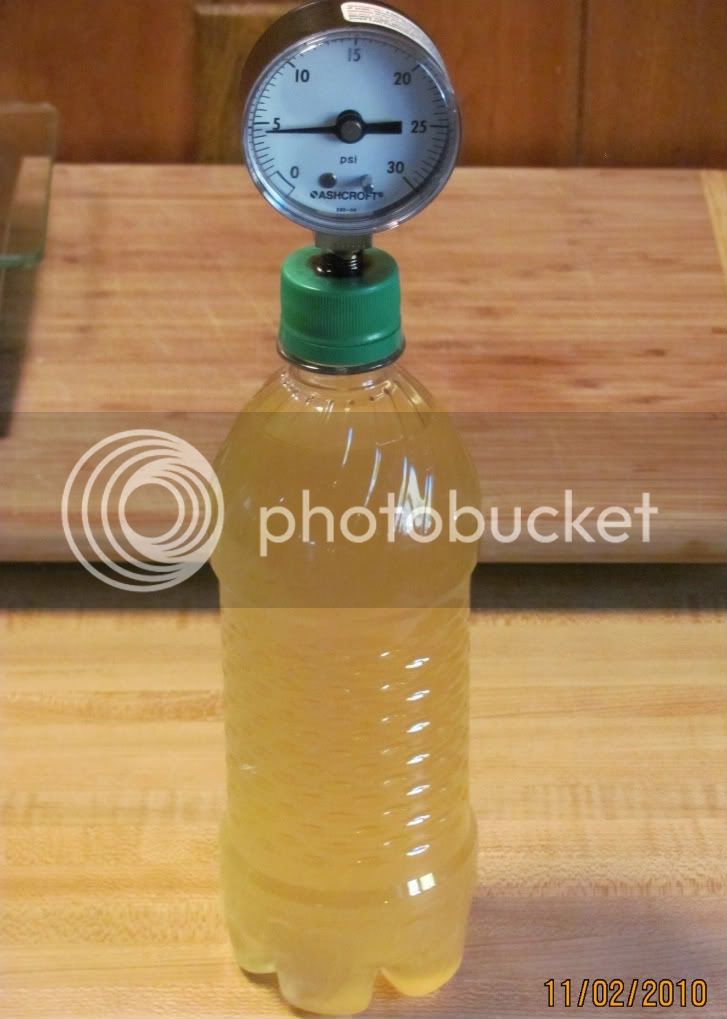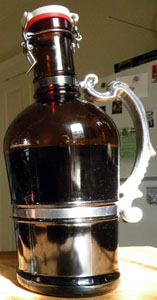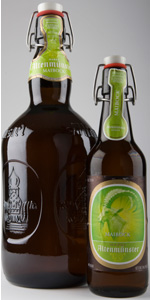Scarthingmoor
Well-Known Member
I've got a 2L growler, conditioned with some corn sugar. I'm wondering if the Growler would take longer to condition than a smaller bottle?

This is because during carbing, the pressure can go above 30 or 40 PSI. I have a thread in the cider forum where I did several tests bottle carbing sweet hard cider. There is allot of data there if your interested.
I have a bottle with a pressure gauge on it. I recorded pressures during the carbing process. This is how the data was generated. I also recorded pressures while pasteurizing the cider.
I recently bottled some lager I made. I also filled my gauge bottle and my lower pressure gauge bottle pegged at 35 PSI as that was the limit of the gauge. It probably ended up in the 40's, but no way to tell for sure.
When we bottle condition beer, we are really simulating force carbing like the keg folks do. We cause a ferment by adding sugar. This creates a high pressure in the bottle. CO2 doesn't like to dissolve in a warm liquid. We then put some bottles in the fridge. The temperature of the liquid drops and the CO2 then begins to dissolve in the liquid.
It seems to take several days at fridge temperatures for the CO2 to fully saturate the liquid for a maximum saturation for that liquid temperature.
While the CO2 is moving into the liquid, the pressure slowly drops. I've monitored this process as well with the pressure gauge.
Pressures go way higher than folks think while bottle conditioning. In the following data, I carbed sweet hard cider and stopped the carbing and then pasteurized the cider when the bottle was at 22 PSI. My Lager went above 35 PSI. The data doesn't show the extremes the pressure rises with beer as I stopped the cider at 22 PSI, but it would have continued if i hadn't stopped it.
The gauge bottle has a nice side effect, it tells you when your bottles are conditioned as the pressure rise stops. I then throw them in the Fridge to cold condition for several days before I open. The gauge also tells you when they are carbed as the pressure drop stops. Pretty basic really.
https://www.homebrewtalk.com/f32/bottle-carbing-idea-final-data-review-205862/

No, when you bottle condition, the slight fermentation we cause by adding priming sugar just builds pressure up in the bottle. The pressures seem to go up into the 30's and 40's PSI from what I've seen.
The CO2 doesn't really move into the liquid until the temperature drops. Some CO2 may, but not the majority of it. CO2 doesn't dissolve into solution until a lower temperature.
This is really what we do when we force carb in a keg. We raise the pressure up when the beer is cold. The CO2 moves into the solution. The tap pressure is lowered for proper delivery and the beer either sets for cold aging, or it is consumed at that time.
What you would see with the pressure gauge (if you use one bigger than my first bottle had. Should use a 100 PSI Gauge) is that the pressure climbs over time and will level off.
Once the pressure levels off, that means all of the priming sugar has been used up by the yeast. Next, you put them into the fridge. You will see the pressure drop over several days. Eventually, it also will level off. I like to let them sit for a few more days after that, but really if the pressure stops dropping, all of the CO2 that can be dissolved at that temperature has been achieved.
.
Simple. It's the ration of contact area just like in a keg. The c02 will need to pressurize the head space (Which takes LESS TIME) in a bigger bottle (More Yeast and sugar, roughly the same head space) but then it has to force that c02 into solution through the same contact area...thus it takes longer.
This is direct from northern brewer website:
Standard issue 64 oz liquid libation transport vessel for the Civilian Brewing Division. This growler features a blank white space for adding in details on the beer inside and date bottled; using a dry-erase marker allows you to change it at any time. Takes a #6 stopper or a 38 mm screw cap. Pressure capable to 2.4 volumes of co2, not recommended for highly carbonated beers. Avoid bottle carbonating or priming with these growlers, as an unintentionally high level of carbonation could cause the glass to break.
http://www.northernbrewer.com/shop/civilian-brewing-division-growler.html

I've successfully carbed in one of those large in a 2L Rock Bottom growler that looks like this:

To avoid posting another thread, maybe I'll just throw a quick question out here as well. Is it better to batch prime or to prime bottles individually? Certainly seems easier to do a whole batch. What's the thinking on this?

Unibrow said:Ok this growler bomb thing took me by surprise. I got a 2L Altenmünster Oktoberfest growler, with a swing top, and used it for bottling/conditioning a red ale. The beer was fully carbed and tasted great after 1+ month conditioning in the growler.
But you're saying these can become huge bottle bombs?
This bottle is HEAVY and the glass seems way thicker and more durable than most beer bottles. So is the danger here because there's almost .5 gallon carbing up? I figured this monstrous bottle would be more safe. Pic of the growler is below (the bigger of the 2 bottles)
I've successfully used growlers to carb in. It takes just as long as regular bottles.
And no I've never had any growler bombs. as long as u don't add more than required amount of priming sugar you'll b fine.
+1 I have had the exact same experience as this guy


Enter your email address to join: